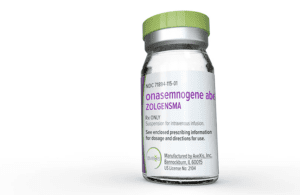
[Zolgensma image from Novartis]
A gene therapy for spinal muscular atrophy (SMA) patients is making waves. Novartis (NYSE:NVS) revealed new long-term data highlighting the durability of Zolgensma (onasemnogene abeparvovec) up to 7.5 years after a single treatment. The data comes from two long-term follow-up studies, LT-001 and LT-002, which examined a range of patient populations and demonstrated a positive overall benefit-risk profile. LT-001 is an ongoing 15-year long-term follow-up study of patients who completed the phase 1 START study. More than 3,000 children have been treated with Zolgensma in clinical trials, managed access programs and commercial settings.
Novartis expects Zolgensma to eventually generate $1.5–2 billion, according to BioPharma Dive. NVS shares were up 1 percent to $83.01 today after announcing the new data.
FDA approved Zolgensma (onasemnogene abeparvovec-xioi) in 2019 for children less than two years old with SMA. At that time, it was the most expensive drug to win FDA approval with a price of more than $2 million.
Comparing SMA treatments and therapies for similar conditions
In the context of other gene therapies for spinal muscular atrophy or similar conditions, Biogen’s (Nasdaq:BIIB) Spinraza (nusinersen) is an FDA-approved treatment for SMA. Although not a gene therapy, it is an antisense oligonucleotide that helps improve motor function in SMA patients through a series of regular spinal injections. Another promising gene therapy is SRK-015 by Scholar Rock (Nasdaq:SRRK), currently in clinical development to treat SMA patients by promoting muscle growth. For other similar conditions, such as Duchenne muscular dystrophy (DMD), several gene therapies are in development, like Sarepta Therapeutics’ (Nasdaq:SRPT) SRP-9001, which is currently in clinical trials. Solid Biosciences (Nasdaq:SLDB) is also developing SGT-001, a gene therapy for DMD patients that aims to restore dystrophin expression and improve muscle function.
The future of gene therapy in treating SMA
The data emphasizes the potential of Zolgensma, with patients in the LT-001 study maintaining all previously achieved motor milestones up to 7.5 years after treatment. Some patients even gained new milestones, such as standing with assistance, during the long-term follow-up period. Novartis’ latest data highlights the potential of gene therapy in treating SMA patients, paving the way for more patients to receive the treatment. As the number of gene therapy recipients increases worldwide, Novartis is committed to expanding access to Zolgensma, offering hope and improved quality of life to SMA patients and their families. The success of Zolgensma may also help drive further research and development of gene therapies for other neuromuscular disorders, providing a new treatment paradigm for these devastating conditions.